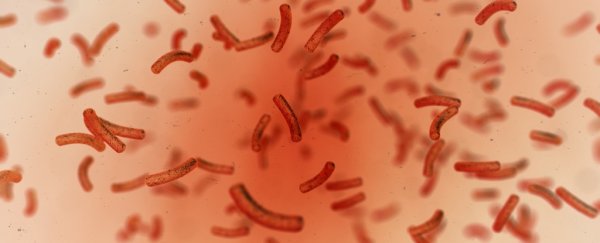An antibiotic with a whole new approach to conquering superbugs has shown promise in early clinical trials.
Unlike other antibiotics currently on the market, the new drug, called cefiderocol, engages in a kind of biological subterfuge that overthrows Gram-negative bacteria from the inside out.
By grabbing onto iron molecules within the body, cefiderocol is able to hitch a ride, without detection, across the bacterium's protective outer membrane.
Once smuggled inside, the drug can then work its magic in the same way as other antibiotics.
"Cefiderocol acts as a trojan horse," explains lead author Simon Portsmouth, a researcher in virology at the global pharmaceutical company Shionigi Inc, which developed cefiderocol.
"The drug uses a novel mechanism of cell entry that takes advantage of the bacteria's need for iron to survive."
As the world's arsenal of antibiotics grow less and less effective, it is becoming increasingly urgent that new drugs are developed.
The Review on Antimicrobial Resistance predicts that deaths from drug-resistant infections could rise from 700,000 every year to 10 million people every year by 2050.
It's a massive problem, and finding a solution to antibiotic-resistant Gram-negative bacteria is the highest priority, according to the World Health Organisation (WHO).
Highly-resistant Gram-negative bacteria are some of the hardest infections to treat and can be deadly. In fact, some reports suggest they can contribute to death in up to 50 percent of all patients who become infected.
A new and better antibiotic is desperately needed, and cefiderocol is the first drug of its kind to make it to late clinical development.
In a phase II human trial, the new drug was tested on 448 adults infected by Gram-negative bacteria, including uncomplicated kidney infections and complicated urinary tract infections (UTIs).
Comparing cefiderocol to the standard antibiotic given in such cases, imipenem-cilastatin, the findings suggest that the new drug is just as effective as current treatments.
It was also found to have slightly less side effects than its contemporary counterpart.
"Cefiderocol was found to be both safe and tolerable in a population of older patients who were very ill with complex comorbid conditions and a wide range of multidrug-resistant pathogens," says Portsmouth.
"Our results support cefiderocol as a novel approach that might be used to overcome Gram-negative resistance."
The research is encouraging, but there are still many questions left unanswered.
What's unclear, for instance, is if cefiderocol will work on kidney infections and UTIs that have become resistant to standard treatments.
Gram-negative bacteria have developed several mechanisms to protect themselves from current antibiotics, including two outer membranes that do not absorb foreign material.
In theory, cefiderocol's cunning mode of action gives it the potential to succeed where other antibiotics have failed. By hijacking the bacterium's own iron-transport system, the new drug has the ability to repeatedly enter the cell.
But this study only compared the effectiveness of the new drug with current antibiotics. It did not investigate the effect of cefiderocol on infections that have grown resistant to current antibiotics.
"Although these results are promising with regard to obtaining approval for cefiderocol and in the context of increasing antimicrobial resistance, scepticism will persist until more evidence is available," wrote Angela Huttner, an expert in infectious diseases at the University of Geneva, in a comment that was linked to the study.
Phase III clinical trials are now underway, and these will examine cefiderocol's effect on pneumonia and antibiotic-resistant infections.
If the new drug lives up to its potential, it could save countless lives.
This study has been published in The Lancet Infectious Diseases.
